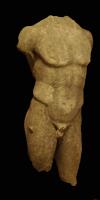-

-
Athlete
-
Remains of a marble statue of a nude male. The head, arms, and lower legs are all missing., Dates to c. 340-300 BCE. May be an athlete, hero, or god., British Museum. “statue.” The British Museum Collections Online. Accessed May 24, 2017. http://www.britishmuseum.org/research/collection_online/collection_object_details.aspx?objectId=3160998&partId=1&searchText=greek
-

-
Athlete
-
Bronze statue depicting a nude athlete., Dates to c. 440-430 BCE., British Museum. “figure.” The British Museum Collections Online. Accessed May 24, 2017. http://www.britishmuseum.org/research/collection_online/collection_object_details.aspx?objectId=399272&partId=1&searchText=roman
-

-
Athlete
-
Bronze statue depicting a nude athlete., Dates to c. 440-430 BCE., British Museum. “figure.” The British Museum Collections Online. Accessed May 24, 2017. http://www.britishmuseum.org/research/collection_online/collection_object_details.aspx?objectId=399272&partId=1&searchText=roman
-

-
Athlete
-
Statue of a nude wrestler standing in a contrapposto pose, missing both forearms. An inscription is located on the base of the statue., Votive statue for Agias in the style of Lysippos. It dates to c. 336-332 BCE. The inscription reads 'You are the first from the Thessalian land to be victorious in the Pankration at the Olympic games, Hagias son of Aknonios, from Pharsalos, [having been victorious] five times at Nemea, three times in the Pythian games, [and] five times at the Isthmos; and no one yet has dragged the trophies from your hands' (Lloyd, 2014)., Lloyd, James. "Agias, Son of Akonios." Ancient History Encyclopedia. Accessed May 5, 2017. http://www.ancient.eu/image/3223/
-

-
Athlete
-
Statue of a nude wrestler standing in a contrapposto pose, missing both forearms. An inscription is located on the base of the statue., Votive statue for Agias in the style of Lysippos. It dates to c. 336-332 BCE. The inscription reads 'You are the first from the Thessalian land to be victorious in the Pankration at the Olympic games, Hagias son of Aknonios, from Pharsalos, [having been victorious] five times at Nemea, three times in the Pythian games, [and] five times at the Isthmos; and no one yet has dragged the trophies from your hands' (Lloyd, 2014)., Lloyd, James. "Agias, Son of Akonios." Ancient History Encyclopedia. Accessed May 5, 2017. http://www.ancient.eu/image/3223/
-

-
Athlete
-
Bronze statue of an athlete wearing a fillet., Dates to the Classical period., British Museum. “figure.” The British Museum Collections Online. Accessed May 24, 2017. http://www.britishmuseum.org/research/collection_online/collection_object_details.aspx?objectId=422719&partId=1&searchText=greek
-

-
Athlete
-
Bronze statue of an athlete wearing a fillet., Dates to the Classical period., British Museum. “figure.” The British Museum Collections Online. Accessed May 24, 2017. http://www.britishmuseum.org/research/collection_online/collection_object_details.aspx?objectId=422719&partId=1&searchText=greek
-

-
Athlete
-
Bronze statue of a nude athlete with arms raised. One hand is missing., Dates to c. 4th century BCE., Metropolitan Museum of Art. "Statuette of an athlete." The Metropolitan Museum of Art Online. Accessed May 24, 2017. http://www.metmuseum.org/art/collection/search/250542
-

-
Athlete
-
Bronze statue of a nude athlete with arms raised. One hand is missing., Dates to c. 4th century BCE., Metropolitan Museum of Art. "Statuette of an athlete." The Metropolitan Museum of Art Online. Accessed May 24, 2017. http://www.metmuseum.org/art/collection/search/250542
-

-
Athlete
-
Bronze statue of a nude male victorious athlete wearing a wreath., Dates to c. 300-100 BCE.
-

-
Athlete
-
Marble statue of a nude male athlete standing in a contrapposto pose with a chlamys draped over his left shoulder. Both forearms are missing., Dates to c. 100-160 CE. This statue is a Roman copy of a Greek original (360-320 BCE)., British Museum. “statue.” The British Museum Collections Online. Accessed May 24, 2017. http://www.britishmuseum.org/research/collection_online/collection_object_details.aspx?objectId=762275&partId=1&searchText=greek
-

-
Athlete
-
Marble statue of a nude male athlete standing in a contrapposto pose with a chlamys draped over his left shoulder. Both forearms are missing., Dates to c. 100-160 CE. This statue is a Roman copy of a Greek original (360-320 BCE)., British Museum. “statue.” The British Museum Collections Online. Accessed May 24, 2017. http://www.britishmuseum.org/research/collection_online/collection_object_details.aspx?objectId=762275&partId=1&searchText=greek
-

-
Athlete
-
Bronze figure of a nude athlete with inlaid silver eyes and an inscription on the front of his right leg., The inscription identifies this as a votive statue from the first half of the first century CE.
-

-
Athlete
-
Bronze figure of a nude athlete with inlaid silver eyes and an inscription on the front of his right leg., The inscription identifies this as a votive statue from the first half of the first century CE.
-

-
Athlete
-
Bronze figure of a nude athlete., British Museum. “figure.” The British Museum Collections Online. Accessed May 24, 2017. http://www.britishmuseum.org/research/collection_online/collection_object_details.aspx?objectId=396976&partId=1&searchText=greek
-

-
Athlete
-
Bronze figure of a nude athlete., British Museum. “figure.” The British Museum Collections Online. Accessed May 24, 2017. http://www.britishmuseum.org/research/collection_online/collection_object_details.aspx?objectId=396976&partId=1&searchText=greek
-

-
Athlete
-
Marble bust of a bare-chested male youth. The hair is cropped very short and the ears show signs of 'cauliflower' damage to the cartilage., Dates to c. 1st or 2nd century CE. Roman copy of a Greek original (c. 4th century BCE). It has been identified as either the head of Herakles or a victorious youth., Metropolitan Museum of Art. "Marble bust of a youth." The Metropolitan Museum of Art Online. Accessed November 15, 2017. https://www.metmuseum.org/art/collection/search/249049
-

-
Athlete
-
Bronze statue of a nude athlete pouring a libation., Dates to c. 470 BCE., British Museum. “figure.” The British Museum Collections Online. Accessed May 24, 2017. http://www.britishmuseum.org/research/collection_online/collection_object_details.aspx?objectId=399285&partId=1&searchText=roman
-

-
Athlete
-
Bronze statue of a nude athlete pouring a libation., Dates to c. 470 BCE., British Museum. “figure.” The British Museum Collections Online. Accessed May 24, 2017. http://www.britishmuseum.org/research/collection_online/collection_object_details.aspx?objectId=399285&partId=1&searchText=roman
-

-
Athlete
-
Marble sculpture of a female athlete wearing a short chiton with one breast bared. She appears to be stepping forward with her arms partially bent. A palm branch decorates the supporting column., Also known as the "Atalanta Barberini". This statue most likely depicts a successful runner due to her outfit and the palm branch included in the sculpture. Attributed to the sculptor Pasiteles and is either his Greek original from the 1st century BCE or a Roman copy from the second century CE.